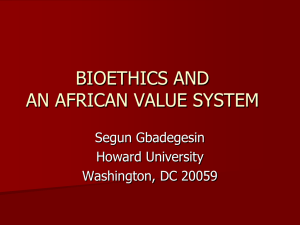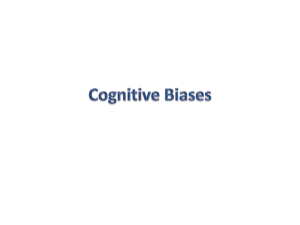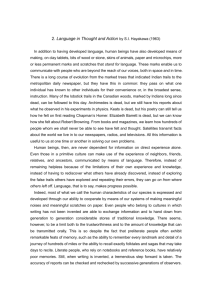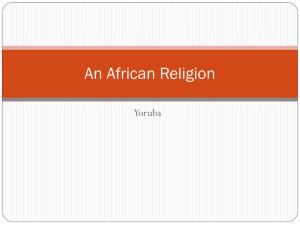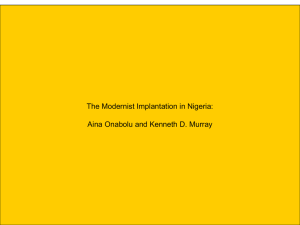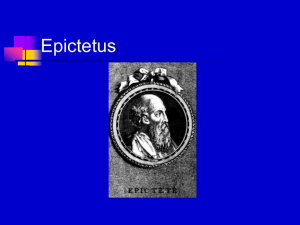The Scientific Universe in Yoruba Religion
advertisement
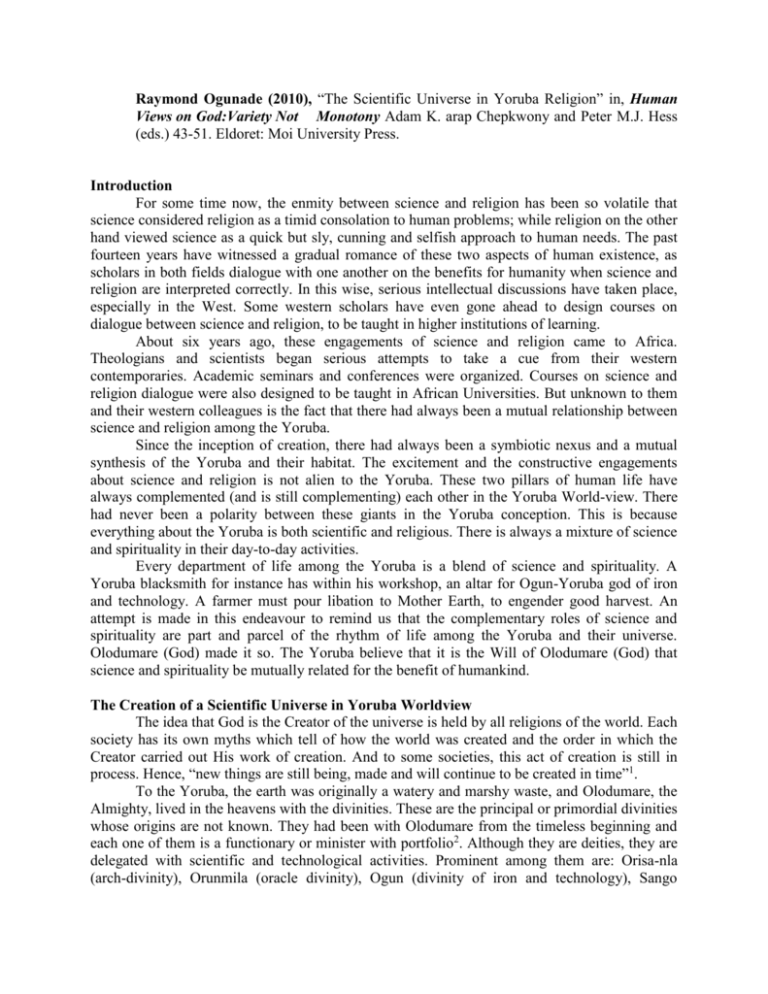
Raymond Ogunade (2010), “The Scientific Universe in Yoruba Religion” in, Human Views on God:Variety Not Monotony Adam K. arap Chepkwony and Peter M.J. Hess (eds.) 43-51. Eldoret: Moi University Press. Introduction For some time now, the enmity between science and religion has been so volatile that science considered religion as a timid consolation to human problems; while religion on the other hand viewed science as a quick but sly, cunning and selfish approach to human needs. The past fourteen years have witnessed a gradual romance of these two aspects of human existence, as scholars in both fields dialogue with one another on the benefits for humanity when science and religion are interpreted correctly. In this wise, serious intellectual discussions have taken place, especially in the West. Some western scholars have even gone ahead to design courses on dialogue between science and religion, to be taught in higher institutions of learning. About six years ago, these engagements of science and religion came to Africa. Theologians and scientists began serious attempts to take a cue from their western contemporaries. Academic seminars and conferences were organized. Courses on science and religion dialogue were also designed to be taught in African Universities. But unknown to them and their western colleagues is the fact that there had always been a mutual relationship between science and religion among the Yoruba. Since the inception of creation, there had always been a symbiotic nexus and a mutual synthesis of the Yoruba and their habitat. The excitement and the constructive engagements about science and religion is not alien to the Yoruba. These two pillars of human life have always complemented (and is still complementing) each other in the Yoruba World-view. There had never been a polarity between these giants in the Yoruba conception. This is because everything about the Yoruba is both scientific and religious. There is always a mixture of science and spirituality in their day-to-day activities. Every department of life among the Yoruba is a blend of science and spirituality. A Yoruba blacksmith for instance has within his workshop, an altar for Ogun-Yoruba god of iron and technology. A farmer must pour libation to Mother Earth, to engender good harvest. An attempt is made in this endeavour to remind us that the complementary roles of science and spirituality are part and parcel of the rhythm of life among the Yoruba and their universe. Olodumare (God) made it so. The Yoruba believe that it is the Will of Olodumare (God) that science and spirituality be mutually related for the benefit of humankind. The Creation of a Scientific Universe in Yoruba Worldview The idea that God is the Creator of the universe is held by all religions of the world. Each society has its own myths which tell of how the world was created and the order in which the Creator carried out His work of creation. And to some societies, this act of creation is still in process. Hence, “new things are still being, made and will continue to be created in time”1. To the Yoruba, the earth was originally a watery and marshy waste, and Olodumare, the Almighty, lived in the heavens with the divinities. These are the principal or primordial divinities whose origins are not known. They had been with Olodumare from the timeless beginning and each one of them is a functionary or minister with portfolio2. Although they are deities, they are delegated with scientific and technological activities. Prominent among them are: Orisa-nla (arch-divinity), Orunmila (oracle divinity), Ogun (divinity of iron and technology), Sango (thunder and electricity divinity), Sopona (divinity of small-pox), and Esu (the Inspector of rituals)3. The divinities used to visit the earth to play and hunt. They came down from the heavens by walking on spiders’ web, which served as bridges. Olodumare decided to turn the watery and marshy4 ground into solid earth. He did not just busy Himself with spiritual matters only. Science is also His invention. In the words of Awolalu and Dopamu: Olodumare looked down on the watery marshy waste and pondered over it. He considered what he could do with it. Could it be left permanently as a waste? Could it not be turned into a useful, purpose spot? Could this great wet monotony not be populated by divinities and other living things? A plan then emerged when Olodumare decided to form the watery, marshy, wet monotony into a solid earth5. In view of this decision by Olodumare, He, therefore, summoned the chief divinity Orisa-nla and commissioned him with the responsibility of structuring the earth included the arrangements of microbes (underneath and on the surface of the earth), the electrons, the protons; the formation of rocks, water, hills, valleys and their lay-out. The separation of sea, land, firmament, and the skies; the order of the sun, moon, and the stars; the arrangements of the various seasons were all mapped out by Orisa-nla at the instance of Olodumare in Yoruba belief. All these phenomenon were delicately and deliberately ordered in nature by Olodumare in order that human beings may observe appreciate and study them and ultimately mediate on how they came to be. Sharon Begley has observed in line with Yoruba thought that “the world was not an endless sequence of unique cases. Without the confidence that there existed a consistent, rational, eternal set of principles governing nature, there wouldn’t be much point in doing science-whose goal is, after all, the uncovering of the regularities of nature that we have come to call laws”.6 Except for lack of understanding, it is obvious that scientific discoveries and inventions developed from these phenomenon. Following the Yoruba creation narration of Awolalu and Dopamu (although Idowu7 had lucidly narrated this Yoruba cosmogony), Olodumare: …gave Orisa-nla the material of a leaf packet of loose earth (or a snail shell full of sand), and for his tools he was given a white hen and a pigeon to spread the earth. Acting on the instruction of Olodumare, Orisa-nla descended upon the watery waste. On getting to a particular spot on the watery marshy void, he poured out the loose earth, and dropped the birds where he had thrown the sand. The birds began immediately to scratch at the sand and scatter it on the marshy waste. And wherever the earth was scattered became dry land. However, the loose earth was scattered unevenly, and there emerged hills, valleys and mountains8. Orisa-nla reported his completion of the assignment to Olodumare. This first phase of earth’s structuring completed: Olodumare instructed his bailiff, also known as His Inspector of works, the Chameleon, to go and inspect the work which Orisa-nla had earlier reported to Olodumare… After two visits to the spot, the Chameleon reported back that Orisa-nla’s work was perfect enough for further operations9. From the two scenarios above, it will appear that the Yoruba cosmogony was in stages, and that scientific inventions started with Olodumare and the divinities. Olodumare conceived the need to structure the earth and initiated it. He delegated Orisa-nla for instance to structure the earth and he in turn demonstrated his creative abilities, his sense of beauty and orderliness in the creation of it. So after the inspection by the Chameleon, Olodumare again commissioned Orisa-nla “to equip the earth. The birds were to increase and multiply and serve as food. Certain trees were to be planted to supply drinks”10, mineral salt, vitamins, furniture and shelter. It is important to note that all that humanity requires for living, convenience, and explorations were made available by Olodumare. The earth was ready for human occupation and control. It was Olodumare’s expectation that humans do these under the guidance of, and in obedience to the ever watchful eyes of the spiritual beings. The Creation of Human Beings The Yoruba have two traditions about the occupation of the universe by human beings. According to Idowu, the first sixteen human beings were prepared by Olodumare from heaven11. This may have informed Awolalu and Dopamu to report that, “a man called Oreluere headed a party of beings, created for the purpose of inhabiting the earth, and came down to the newly created solid earth”12. This implies that God is the greatest Scientist. No human scientist has ever created a human being. At this stage was “the beginning of human occupation of the earth. People began to increase and multiply, but they did not have enough water for use. Orisa-nla, therefore, appealed for more water, and Olodumare sent rain”13. The first of the two sets of human beings that occupied the earth at creation came from heaven under the leadership of Oreluere, who was once living with Olodumare in heaven. This set of humans may account for the generation of geniuses and near-perfect people, that we sometime come by. We can reasonably conclude that they were created by Olodumare in heaven14. However, Olodumare must have deemed it necessary to create more human beings, this time around on earth-by someone else, in the person of Orisa-nla. One wonders what informed this decision. When we asked the Yoruba elders why this was so, we were told that Olodumare wanted in that way. According to Yoruba tradition, the second set of human beings was created on earth, as narrated by Idowu: Orisa-nla was assigned another special job. He was made the ‘creator’ of human physical features… to mould man’s physical form from the dust of the earth15. He thus became the sculptor divinity. But the right to give life Olodumare reserved to Himself alone for ever.16 Assigning the creation of the second set of human beings to Orisa-nla may look worrisome. This is because according to Dopamu, Orisa-nla: …could, however, do this accordingly as he liked it. That is to say that he could make human figures perfect or defective, white or black, shapely or deformed.17 This aspect of human creation, as evidenced in the variety of structural human forms calls for concern especially, when we consider the defective human beings (the blind, deaf, dumb, hunchback, lame, etc.). At adult-hood, these set of human beings are likely to feel inadequate or incomplete, especially when they see other “physically completed” human beings. Orisa-nla soon finished with the moulding of human beings. They were lifeless since “it was Olodumare’s prerogative, absolute concern, to make the physical form a living being by putting in it the essence of being or life”18. According to the creation narration, tradition has it that “on one occasion, Orisa-nla tried to spy Olodumare at work, to know how the lifeless forms became living beings. Olodumare saw this conspiracy and forestalled him by making him fall into a deep sleep only to wake and find all the forms in the stock become human beings”19. Olodumare thus performed the first anesthesia on Orisa-nla, albeit without sedative. Upcoming scientists were to imitate this later, this time with the aid of powerful sedative drugs. At this stage of creation according to the Yoruba genesis, we have two kinds of human beings inhabiting the earth – the ones from heaven and the ones moulded by Orisa-nla. The impression is given that those from heaven have no deformity, while those moulded on earth have defective forms. Orisa-nla is also responsible for the moulding of black and white humans in Yoruba belief. As soon as human beings began to inhabit the earth, there was good relationship between the heaven and the earth. Everything was very good at the beginning, “the created order enjoyed what was good20 and there was harmony and uninterrupted relationship, communion and fellowship between man and the spiritual world”21. This was the Will of Olodumare regarding His universe – that there should exist a close and mutual relationship between the created world (universe) and the heaven (spiritual or religious). The closeness of the skyey heaven to the earth was such that the people could touch it22. This was evident in the fact that people could go to heaven and request for whatever they needed as many times as possible23. Besides Orisa-nla, only one divinity was allowed by Olodumare to know the secrets of human beings, and that is Orunmila (the oracle divinity). He was there at the beginning and knew how the creation begun and was completed. He was also given the privilege of knowing the secret of the existence of all other divinities too.24 He has been endowed with extraordinary wisdom and foreknowledge. This is the reason why the Yoruba consult him from time to time in all matters of life importance. Other divinities seek guidance from him, too. Other divinities also lived freely among the people over-seeing all the aspects of life, as they assisted Olodumare in the theocratic governance of the Universe. Comments on the Creation of the Universe and Human Beings Scholars have written volumes on the creation stories in the first two chapters of the book of Genesis. Short as the stories are (in terms of the length and pages they take in the Bible) they have attracted thousands of publications and commentaries. Indeed, the stories form the basis of creation/evolution controversies which have continued to rage today. If the biblical stories have continued to attract comments, the Yoruba creation story, and other African creation stories deserve to be commented on. The Yoruba creation story, like any other creation stories of the world, is a myth but myth is not necessarily false25. There was a time when muthos (myth) had almost the same meaning and conception as logos (word). Both could be interpreted then as language of truth or expression about truth26. But the Greek philosophers soon brought a dichotomy between muthos and logos, with the former expressing falsehood or fantasy and the latter expressing truth27. This was the situation until Homer and Hesiod established the oracular power of myths through which most of the traditional past events were unravelled.28 Modern writers have seen anew the possibility of interpreting myth to connote reality. Myth today is seen as a means of expressing reality. It is a means of rationalizing existence, and giving explanation about reality. Hence, we can describe myth as human attempts at giving meaning to the physical and the unseen world just as science presents physical evidence (in form of scientific inventions) from the various ideas in the human mind. Human thoughts, ideas, concepts, and theories become meaningful in scientific creations. For example, the creation of cars, elevators, mobile phones, television sets, nuclear weapons, computers, the internet, orthodox and indigenous medicines, and host of other scientific human-made items, were first conceived as an idea in the human mind. This human mind is not visible; it is not tangible; and yet its existence cannot be denied. The human mind gives vent to scientific inventions, which in themselves derive materials from nature-the handiwork of Olodumare. What is incomprehensible and unrevealed to the human mind is yet unknown and will always remain a mystery and subject of controversy. This is the realm of religion and spirituality, and it is “inaccessible to the understanding of rational reasoning”.29 The human mind is not human-made. It is created by God. Therefore, spirituality gave birth to science and the physical environment. There are different categories of myth, including cosmogonic myths, aesthetic myths, myths of evolution of living things, myths of suffering, etc.30 But our concern in this paper is with cosmogonic myth which is about the creation of the universe and human beings. In the account of Yoruba cosmogonic myths above, a closer consideration will reveal a number of accounts that are confusing, and those that are logical. For instance, like most African creation stories, the Yoruba creation stories create the picture that creation is not ex-nihilo. That is, the created order (living and non-living) were not created out of nothing. This means that the world was created out of an already existing material. Hence, all the materials given to Orisa-nla, out of which he laid the foundation of creation, already existed. Also, before the earth was created, the divinities were fond of coming to earth to hunt. They could not have been hunting vast, watery, marshy land. They must have been hunting animals. When the question was asked where all these pre-existing creatures came from. The response of the Yoruba was, “God created them all”31. Apart from this observation of pre-existing creatures, the impression is also given that there were some creatures in heaven with Olodumare part of which He gave Orisa-nla. Hunting might also be forbidden in heaven, since the divinities came down to earth to hunt instead. In line with the above, is the fact that some sixteen human beings, led by Oreluere, came from heaven to be the first set of people to inhabit the earth. If there are creatures in heaven, before the creation of the earth, is it not possible for Olodumare to have populated the earth with them? But rather He chose to delegate Orisa-nla to continue the rest of creation. From the Yoruba standpoint, Olodumare delegated assignments to some of the divinities in His theocratic governance of the universe32. The divinities are spiritual beings but they also oversee human creativities and creations. The graphic account of the Yoruba creation story shows Olodumare, as being in charge. He chose a few of His divinities and assigned them with responsibilities in their area of specialties. For example the Chameleon was known to be a very careful creature. This is even evident in the way he moves. Hence he was chosen for inspection. When Orisa-nla was done with the moulding of human beings, his limitation as not being Olodumare was obvious. He could not put life into them. This can only be done, and it was done by Olodumare. The Yoruba believe that Olodumare created human beings for the purpose of inhabiting and managing the earth in an atmosphere of peace and harmony. Whether some came from heaven, and some were moulded on earth, “man did not come into being of his own accord, but originated in consequence of the WILL of a Supreme Maker”33. This mode of human appearance into existence, and of course into the world, places on him/her moral and spiritual responsibilities. This “essence of being put in man by God makes him capable of recognizing divine visions and things, as well as comprehending, reflecting, and giving expression to divine revelation”34. This “essence of being” which God endowed human beings with, which gives them some measure of liberty and freedom, has also become a form of snare to them. Awolalu and Dopamu put it very succinctly: …man is endowed with freedom, moral freedom. He can therefore use that freedom to enter into God’s fellowship or to resist THE WILL OF GOD. But this does not mean that man is created with freedom to do everything and anything. The freedom should be utilized for the unique purpose of God’s fellowship and obedience. Man also, in using his freedom, has to put into consideration his own well being which must not be abused; he must also consider other persons and the society in which he lives. The moment man abuses his freedom, his well being will be disrupted… until man used his freedom wrongly and that free inter-course disappeared35 (emphasis mine). From the excerpt we see clearly that God gave human beings freedom. This freedom is the beginning of human scientific inventions. But he/she is at the liberty to do whatever he/she likes with it. Positive wisdom dictates that human beings apply this freedom in a way that their Creator is happy and creation also is peaceful. The Yoruba believe that it is the Will of God that human freedom be used to enhance harmony amongst fellow human beings, not to break it down; that whatever the creativity that is expressed out of this human freedom should engender human harmony and not devastate it. This is the reason why the Yoruba conceive that when human freedom is misused: …no other result can we expect than confusion, hatred, violence, war, oppression and chaos. Thus human freedom should bring total well-being which is peace, prosperity, smoothness of life, welldoingness, goodness and the bliss which man may enjoy in this world. It should bring a state of affairs in human life, where flagrant atrocity does not present itself to man’s mind, where none is denied the benefit of freedom, the pleasure of society and the advantages of religious worship. In such a situation where these evils are absent, the well-being of man is assured; everything will be peaceful and harmonious. But when human freedom is used contrarily, the well-being is disrupted, man is then thrown into doubt uncertainty and confusion36. What has emerged from the creation of the universe and human beings from Yoruba standpoint is that God (Olodumare) has a Will. It is His Will that a scientific and peaceful universe be created. His Will necessitates the creation of human beings. It is His Will that the divinities of heaven should function in the creation of the universe and all that are in it. It is His Will that human beings should manage, administer, tend, care for, and populate it. It is also His Will at the same time that human beings should be moral agents with obedience to His rules and laws, and has mutual respect for one another and nature. His Will necessitates times and seasons, human wisdom and knowledge, human acts and accountability. Everything in the universe exhibits Divine Will, including a return to Him after death. We have also seen that Orisa-nla (the arch-divinity; the sculptor divinity) was responsible for the moulding of the human body out of clay. This makes Orisa-nla the first divinity-scientist according to Yoruba tradition. However, the physical bodies moulded by Orisa-nla were lifeless. The Yoruba say that what Olodumare puts in the lifeless figure is a divine spark which gives human beings life. It is this that is called emi or soul, which makes human beings rational and different from other animals37. Emi therefore, is always linked with Olodumare and, indeed, is a gift from Olodumare to human beings. The Yoruba believe that this emi goes back to Olodumare when a person dies. Human Beings and Their Scientific Universe in Yoruba Belief From the moment of creation, the Yoruba believe that God had given human beings power and authority to tame and control the universe. The birds used by Orisa-nla in creating the world were to be food for human beings, while some trees were to supply drink38. According to the Yoruba, when people began to multiply in the world, they did not have enough water to drink. Consequently, they applied to Olodumare who sent rain39. The universe in which human beings found themselves was full of peace and harmony. As times went on human being created complexities and problems which, of course, were not insurmountable. Therefore, Olodumare sent Orunmila, the oracle divinity, to assist human beings to overcome their problems. Thus, while Orisa-nla represented Olodumare in matters of creation, Orunmila represented Him in matters of wisdom, guidance, fore-knowledge, and declaring the Will of Olodumare40. The Yoruba believe that human beings cannot have a complete understanding in their exploration of the universe without constant consultations with the spiritual entities that oversee the entire universe. There is another divinity that played important role among human beings from the beginning. The Yoruba believe that Olodumare demanded obedience and worship from human beings from the genesis of things. Human beings were created for a purpose and that purpose is to reverence the exaltedness of Olodumare through worship and appropriate sacrifice41. Olodumare, therefore, commissioned Esu, as the Inspector General of rituals and punisher of moral offenders, to always report back to Him whenever human beings erred42. The Yoruba believe that the universe belongs to Olodumare, and that human beings are only tenants on His universe. It is predestined that humans should live for a short time here on earth and then return to Olodumare, their Maker43. The Yoruba claim that a person’s physical environment is an illusion since his/her existence on earth is very transient and temporary. They say, for instance: Aye loja, orun ni ile (The earth is a market place, but heaven is home). The implication of this saying is that no matter how long a person lives in this world he/she is predestined to die and return to heaven which is the permanent home of human beings. Conclusion The conclusion that can be drawn from the foregoing is that the complementary roles of science and spirituality are not alien to Yoruba Religion; and that Olodumare created the universe as scientific explorative field for human observation, appreciation, discoveries and inventions, so that they can return worship to Him. We have also seen from the preceding discussions that all of human activities and relationship with one another and with nature should be conducted in peace and harmony, and in consultation with the spiritual entities, in order that the integrity of creation is maintained; the symphony and the sacredness of life are healthy and upheld. As an appeal for peaceful co-existence, we offer as food for thought a popular Yoruba song: Ile aye yii ki ise te nikan A kan nkoja lo nibe ni. Orun nikan ma ma nile Ka sa ma huwa ire. Nitori ehin ola E je ki a se aye rere. Ki a le ba ni irorun ni orun. E saye re.44 Meaning: This world does not belong to anyone We are just passing through. Heaven alone is the home Let us behave well always. Because of latter life Let us do good here on earth. So that we can live a life of comfort in heaven. Do good while on earth. 1 2 3 4 5 6 7 8 9 10 11 12 13 14 15 16 17 18 19 20 21 22 23 24 25 26 27 28 29 Notes and References Oral interview, Professor Ade P. Dopamu, 58 years, Department of Religions, University of Ilorin, Ilorin, 10th October, 2003. J. Omosade Awolalu and Dopamu, P. Adelumo, West African Traditional ReligionRevised Edition, (Ibadan: Macmillan Publishers, 2005), p.76. E. Bolaji Idowu, Olodumare: God in Yoruba Belief (London: Longman, 1962), p.70; see also J. Omosade Awolalu and Dopamu, P. Adelumo, West African Traditional Religion, p.54; also see P. Ade Dopamu, Esu: The Invisible Foe of Man (IjebuOde: Sebiotimo Publications, 2000), p.117. Cf. Gen. 1:2. J. Omosade Awolalu and Dopamu, P. Adelumo, West African Traditional…,p.55. Sharon Begley, “Introduction”, in Michael Reagan (ed.). The Hand of God: Thoughts and Images Reflecting the Spirit of the Universe (Philadelphia and London: Templeton Foundation Press, 1999), p.10. E. Bolaji Idowu, Olodumare: God in Yoruba… Chapter 3, pp.18ff. J. Omosade Awolalu and Dopamu, P. Adelumo, West African Traditional…, p.55. Ibid. Ibid. p.56. E.B. Idowu, Olodumare: God in Yoruba… p.19. J. Omosade Awolalu and Dopamu, P. Adelumo, West African Traditional…, p.56. Ibid. J. Omosade Awolalu, Yoruba Beliefs and Sacrificial Rites (UK: Longman Group Limited, 1979), p.13 Cf. Gen. 2:7. In the Genesis account of creation note that the Christian God made man by Himself, unlike this particular Yoruba creation story where Olodumare delegated Orisa-nla to mould human’s “physical parts”. The similarity in evolving human out of the dust is significant. It points to a basic and fundamental constituent of human beings-the dust of the earth. E. Bolaji Idowu, OLODUMARE: God in Yoruba Belief- Revised and Enlarged edition (Nigeria: Longman Nigeria Plc, 1996), p.19. J. Omosade Awolalu and Dopamu, P. Adelumo, West African Traditional…, p.56. Ibid. Ibid. Cf. Gen. 1:31. J. Omosade Awolalu and Dopamu, P. Adelumo, West African Traditional…, p.56. Ibid. Ibid. E. Bolaji Idowu, OLODUMARE: God in Yoruba…, p. 20. Professor Ade P. Dopamu, Lecture Notes on “MYTH” – RCR 311: African Mythology, Department of Religions, University of Ilorin, 2004, p.58. Ibid., p.4 Ibid., p.4b Ibid. M.Y. Nabofa, “The Problems of Communicating African Mystical Experience”, in Ade. P. Dopamu, et. al (eds.) DIALOGUE: Issues in Contemporary Discussion. (Lagos: Big Small Books, 2006), p.134. 30 Raymond Ogunade, “A Comparative Study of the Concept of the Will of God in Yoruba Religion and Christianity”, unpublished Ph.D thesis (University of Ilorin: Department of Religions, 2005), p.88. 31 32 33 34 35 36 37 38 J. Omosade Awolalu and Dopamu, P. Adelumo, West African Traditional…, p.66. Cf. Gen. 1:26. J. Omosade Awolalu and Dopamu, P. Adelumo, West African Traditional…, p.67 Ibid. Ibid., pp.67-68. Ibid., p.68 Ibid., p.158. Ibid., p.56; see also J. Omosade Awolalu, Yoruba Beliefs and Sacrificial Rites (London: Longman, 1979), p.13. Ibid., J. Omosade Awolalu and Dopamu, P. Adelumo. Ibid., p.79; see also P. Ade Dopamu, ESU: The Invisible Foe…, p.116. P. Ade Dopamu, ESU: The Invisible Foe…, p.117; see also Wande Abimbola, Sixteen Great Poems of Ifa, (UNESCO, 1975), p.3. Ibid., P. Ade Dopamu. E.B. Idowu, Olodumare: God in Yoruba…, p.21. Afuji song composed by Alhaji Sikiru Ayinde Barrister on “Ile Aye” (The World), 1979. 39 40 41 42 43 44
